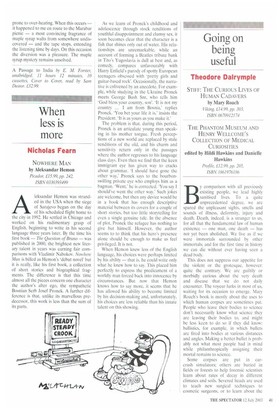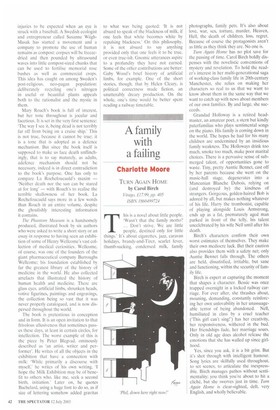Going on being useful
Theodore Dalrymple
STIFF: THE CURIOUS LIVES OF HUMAN CADAVERS by Mary Roach Viking £14.99, pp. 303, ISBN 0670912174 THE PHANTOM MUSEUM AND HENRY WELLCOME'S COLLECTION OF MEDICAL CURIOSITIES edited by Hildi Hawkins and Danielle Hawkins
Profile, £12.99, pp. 205, ISBN 18'61976186
By comparison with all previously existing people, we lead highly sanitised lives. To a quite unprecedented degree, we are spared the unpleasant sights, smells and sounds of illness, deformity, injury and death. Death, indeed, is a stranger to us, for all that the fundamental law of human existence — one man, one death — has not yet been abolished. We live as if we were immortals surrounded by other immortals; and for the first time in history we can die without ever having seen a dead body.
This does not suppress our appetite for the violent or the grotesque, however: quite the contrary. We are guiltily or morbidly curious about the very death and disease that we do not daily encounter. The voyeur lurks in most of us, waiting for its occasion to emerge. Mary Roach's book is mostly about the uses to which human corpses are sometimes put. People who leave their bodies to science don't necessarily know what science they are leaving their bodies to, and might be less keen to do so if they did know: ballistics, for example, in which bullets are fired into bodies at various distances and angles. Making a better bullet is probably not what most people had in mind while philanthropically assigning their mortal remains to science.
Some corpses are put in carcrash simulators; others are buried in fields or forests to help forensic scientists learn about rates of decay in different climates and soils. Severed heads are used to teach new surgical techniques to cosmetic surgeons, or to learn about the injuries to be expected when an eye is struck with a baseball. A Swedish ecologist and entrepreneur called Susanne WiighMasak has started a movement and a company to promote the use of human remains as compost: corpses will be freezedried and then pounded by ultrasound waves into little compost-sized chunks that can be used to fertilise memorial rose bushes as well as commercial crops. This idea has caught on among Sweden's post-religious, neo-pagan population: deliberately recycling one's nitrogen in useful or beautiful plants appeals both to the rationalist and the mystic in them.
Mary Roach's book is full of interest, but her tone throughout is jocular and facetious. It is set in the very first sentence: 'The way I see it, being dead is not terribly far off from being on a cruise ship.' This is not true, because it cannot be true; it is a tone that is adopted as a defence mechanism. But since the book itself is supposed to make us face death unflinchingly, that is to say maturely, as adults, adefence mechanism should not be necessary, indeed is in direct contradiction to the book's purpose. One has only to compare La Rochefoucauld's maxim — 'Neither death nor the sun can be stared at for long' — with Roach's to realise the terrible shallowness of her book. La Rochefoucauld says more in a few words than Roach in an entire volume, despite the ghoulishly interesting information it contains.
The Phantom Museum is a handsomely produced, illustrated book by six authors who were asked to write a short story or an essay in response to having seen an exhibition of some of Henry Wellcome's vast collection of medical curiosities. Wellcome, of course, was one of the founders of the giant pharmaceutical company Burroughs Wellcome; his foundation established by far the greatest library of the history of medicine in the world. He also collected artefacts that illustrated the history of human health and medicine. There are glass eyes, artificial limbs, shrunken heads, votive figurines, paintings and engravings, the collection being so vast that it was never properly catalogued, and is now dispersed throughout the world.
The book is pretentious in conception and in form. It is an open invitation to that frivolous allusiveness that sometimes passes these days, at least in certain circles, for intellection. The worst example of this is the piece by Peter Blegvad, ominously described as an artist, writer and performer'. He writes of all the objects in the exhibition that have a connection with milk: 'While primarily a discourse with myself,' he writes of his own writing, 'I hope the Milk Exhibition may be of benefit to others who, like me, seek a second birth, initiation.' Later on, he quotes Bachelard, using a huge font to do so, as if size of lettering somehow added gravitas to what was being quoted: 'It is not absurd to speak of the blackness of milk, if one feels that white becomes white by repulsing blackness,' On this philosophy, it is not absurd to say anything provided only that one feels it to be true, or even true-ish. Gnomic utterances aspire to a profundity they have not earned. Some of the other contributions are better: Gaby Wood's brief history of artificial limbs, for example. One of the short stories, though, that by Helen Cleary, is political correctness made fiction, an unutterably dreary production. On the whole, one's time would be better spent reading a railway timetable.



































































 Previous page
Previous page